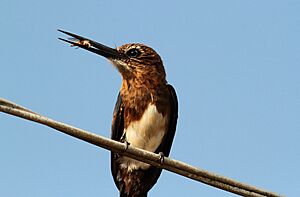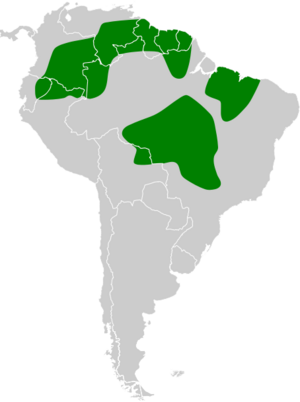Brown jacamar facts for kids
Quick facts for kids Brown jacamar |
|
|---|---|
 |
|
| Conservation status | |
| Scientific classification | |
| Genus: |
Brachygalba
|
| Species: |
lugubris
|
 |
|
The brown jacamar (Brachygalba lugubris) is a cool bird that lives in the warm, sunny parts of South America. It's part of the Galbulidae family, which are known for their bright colors and long beaks. You can find this bird in countries like Bolivia, Brazil, Colombia, Ecuador, French Guiana, Guyana, Peru, Suriname, and Venezuela.
Contents
About the Brown Jacamar Family
The brown jacamar is related to other jacamar birds, like the dusky-backed, pale-headed, and white-throated jacamars. They are all part of a group called a "superspecies," which means they are very closely related.
Scientists have found seven different types, or subspecies, of the brown jacamar. These are slightly different versions of the same bird, often found in different areas. Some of these subspecies were once thought to be completely separate species.
What Does the Brown Jacamar Look Like?
The brown jacamar is a medium-sized bird, usually about 14 to 18 centimeters (5.5 to 7 inches) long. It weighs around 16 to 23 grams (0.5 to 0.8 ounces), which is about the same as a few quarters.
Its upper body is mostly brown, with the lower back being a darker brown that shines with a greenish-black color. Its wings are blackish with a pretty blue shimmer. The chin and throat are a light off-white color. The chest and sides are a reddish-brown, while the lower chest and belly are off-white or a light yellowish-brown. Different subspecies might have slightly different shades of these colors.
Where Do Brown Jacamars Live?
Brown jacamars live in three separate areas in northern South America, mostly to the east of the Andes mountains.
They prefer to live in different types of forests, including:
- Terra firme forests: These are forests on higher ground that don't flood.
- Várzea forests: These are forests that get flooded by rivers.
- Gallery forests: These are forests that grow along rivers and streams.
You can find them in both old, untouched forests and newer forests that have grown back. They like to hang out in the tops of trees, along the edges of forests, and in bushy clearings. Sometimes, they are also seen along waterways in savanna areas or on white sand soils.
Brown jacamars usually live in lowlands, up to about 900 meters (3,000 feet) high. But in Venezuela, they have been spotted as high as 1,500 meters (5,000 feet).
How Do Brown Jacamars Behave?
What Do They Eat?
The brown jacamar loves to eat all sorts of insects. It often sits on open branches, either alone or in small groups. When it sees a flying insect, it quickly flies out to catch it in the air, then returns to its perch to eat.
How Do They Raise Their Young?
Scientists haven't found many brown jacamar nests yet, so we don't know a lot about them. However, it's thought that they probably dig burrows in soil banks or make nests inside termite mounds in trees. In Colombia, a family with three young birds was seen in March, and other birds ready to breed were noted in May.
What Sounds Do They Make?
The brown jacamar has a unique song. It sounds like a "tick tick tick ti ti ti ti tit t t t" or "plee, plee, plee-plee-plee’ple’pe’pe’e’e’e" that gets lower and ends in a stutter. You can hear an example of its song here. Its calls are sharp sounds like "hilew" or a lower "chewee." You can listen to its calls here.
Are Brown Jacamars in Danger?
The IUCN (International Union for Conservation of Nature) has looked at the brown jacamar and decided it is a species of Least Concern. This means that it is not currently considered to be in danger of disappearing.
The bird is common in some areas and less common in others. It lives in several protected areas, which helps keep it safe. Experts believe that cutting down some trees (selective logging) in its habitat probably won't harm it too much.
However, one specific subspecies, B. l. phaeonota, is only found in a very small area. Because of this, more studies are needed to understand its conservation status and how much space it needs to live.


